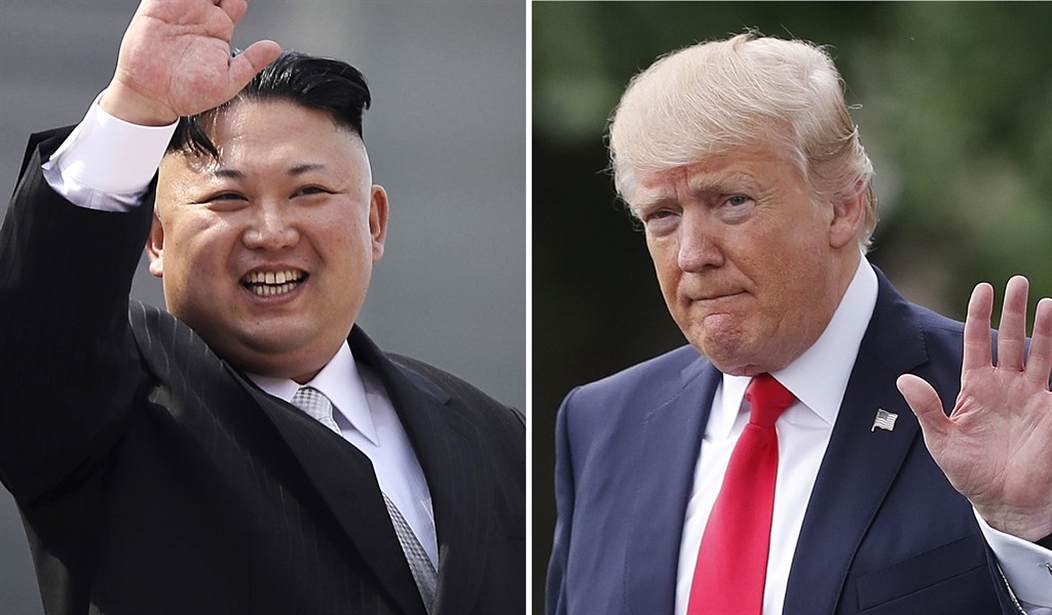Will North Korea attack Guam, as promised, or just conduct a high-risk missile test? The regime’s state broadcaster announced earlier today that the Kim regime has finalized plans to simultaneously launch four missiles at the US territory later this month, targeting international waters a few miles off of its coast. The provocative act, however, will not involve either ICBMs or nuclear warheads, and might give the US an opportunity to demonstrate an ability to negate North Korea’s missile technology:
Sometime in mid-August, North Korea says it is planning for the simultaneous launch of four non-nuclear Hwasong-12 rockets that would fly over the islands of Japan and into the ocean, landing just 18 to 25 miles from the U.S. airbase on the island territory of Guam.
North Korean state television said the launch would be sent as a warning to the U.S. — pending approval from Kim Jong Un.
This doesn’t appear to be as much a threat than an announcement of a missile test, which would actually be an improvement from North Korea. Let’s recall the original threat from Pyongyang. Their statement referred to a plan “for making an enveloping fire at the areas around Guam with medium-to-long-range strategic ballistic rocket Hwasong-12 in order to contain the US major military bases.” That could be read in a couple of different ways — either as a warning of an attack on US forces, or as a show of force to confront American forces short of an actual attack. The implication at the time was the former, as a lesson to “the air pirates of Guam,” but there’s enough wiggle room for a little backpedaling now.
This plan, as described by North Korea’s state media, doesn’t quite measure up to either version, including in a literal sense. Pyongyang plans to conduct a missile test that will fall well short of US waters around Guam, assuming the targeting systems on their Hwasong-12 operates precisely. (If they try this, the Kim regime had better hope it’s precise.) Dropping missiles into the ocean 25 miles short of Guam will hardly create “an enveloping fire” around the military bases; the splashdown probably won’t even be visible from the shore.
Ironically, it might provide the US with more opportunity here than North Korea. The Hwasong-12 is the type of missile against which the THAAD system was designed to defend, and the US has those systems installed all along the path of the missiles that Pyongyang helpfully laid out in its announcement. While there may be value in keeping those capabilities under wraps (and some risk of embarrassment if used unsuccessfully), a successful THAAD use against the launch would throw egg on the face of the Kim regime and expose their inferior standing on military technology.
That risk might be enough for Kim Jong-un to avoid deploying this plan, although it’s tough to calculate just how rational the regime actually is. They’re rational enough to edge back from their suggested attack on Guam, but Kim may not have room to show any weakness now, lest his inner circle decide he’s weak enough to depose. That’s the problem with writing checks with your mouth that your military can’t cash.
Donald Trump is facing blowback for allegedly running his mouth too, but not from the governor of Guam. Eddie Baza Calvo, who’s been agitating for more autonomy from Washington, puts himself foursquare behind Trump in this crisis. “As far as I’m concerned, as an American citizen,” Calvo told Fox News’ Brian Kilmeade last night, “I want a president that says that if any nation such as North Korea attacks Guam, attacks Honolulu, attacks the west coast, that they will be met with hell and fury.” Calvo also reminds Kilmeade of Guam’s THAAD capabilities, and seems pretty sanguine about the prospects in case Kim follows through on his threat.








Join the conversation as a VIP Member